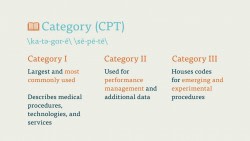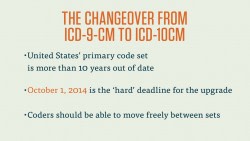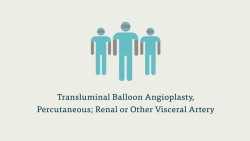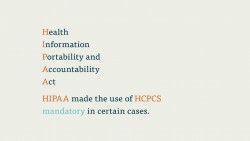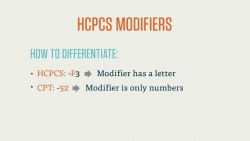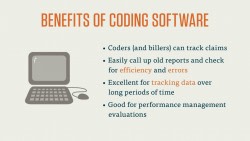In this course, we’ll look at the third major code set: Healthcare Common Procedure Coding System (HCPCS), commonly pronounced “hicks-picks.”
This code set is based upon CPT. In fact, the first level of HCPCS is identical to CPT. That might sound a little confusing, so let’s take a step back.
HCPCS was developed by the Centers for Medicare and Medicaid (CMS) for the same reasons that the AMA developed CPT: for reporting medical procedures and services. Up until 1996, using HCPCS was optional. In that year, however, the government passed the Health Information Portability and Accountability Act, or HIPAA. We’ll look closer at that very important piece of legislation in later courses, but for now all you need to know is that HIPAA made the use of HCPCS mandatory in certain cases.
Coders today use HCPCS codes to represent medical procedures to Medicare, Medicaid, and several other third-party payers. The code set is divided into three levels. Level one is identical to CPT, though technically those codes, when used to bill Medicare or Medicaid, are HCPCS codes. CMS looked at the established CPT codes and decided that they didn’t need to improve upon or vary those codes, so instead they folded all of CPT into HCPCS.
To clarify: if you are coding, say, the placement of a tracheal stent for an elderly patient who is on Medicare, you would still use the CPT code 31631. However, because that code is going to Medicare, and not another payer, the code you’ve selected is technically a HCPCS code. For the most part this is just a technicality, but it can be confusing.
Where the real difference between CPT and HCPCS comes in is in Level II of HCPCS and the HCPCS modifiers. We’ll cover Level II codes here and work on HCPCS modifiers in the next course.
Level II HCPCS codes
Level II HCPCS codes are designed to represent non-physician services like ambulance rides, wheelchairs, walkers, other durable medical equipment, and other medical services that don’t fit readily into Level I. Where CPT describes the procedure performed on the patient, it doesn’t have many codes for the product used in the procedure. HCPCS Level II takes care of those products and pieces of medical equipment.
Level II codes are, like Level I, five characters long, but Level II codes are alphanumeric, with a letter occupying the first character of the code. These codes, like those in ICD and CPT, are grouped together by the services they describe, and are in numeric order.
You can generally refer to the range of codes by their initial character. J-codes, for example, are the codes for non-orally administered medication and chemotherapy drugs. J-codes are some of the most commonly used HCPCS Level II Codes.
For a full breakdown of HCPCS Level II codes by their alphabetic grouping, be sure to download our ebook.
HCPCS code manuals have an index and a large table of drugs. Whenever a coder is coding the delivery of a drug or medication, they should always use the drug table. Coding for medication is one of the most important parts of using HCPCS, and the drug table will provide much more accurate information on where to find the correct code.
Coders use HCPCS codes much like they would ICD or CPT codes. Upon receiving a medical report, you’d take notes on which procedure was performed, which products were prescribed, injected, or otherwise delivered to the patient, and then you’d use your HCPCS code set to find the appropriate code.
Be aware that when coding with HCPCS, you’re going to have to strive for an even higher level of specificity than with CPT. Since this code set has codes for all different variations and amounts of equipment and medicine, you’ll have to stay as close to the medical report as possible to make sure you’re coding the correct procedure. Look at it this way: 20 ten-mg capsules of antibiotics is going to cost more than ten ten-mg capsules, right? That’s what you have to watch out for with HCPCS.
Here’s an example. A patient receives an injection of 20 mg of adalimumab to temporarily relieve the signs of rheumatoid arthritis. If you received this medical report, leaving aside the CPT procedure code and the ICD diagnosis code, you’d look at the amount of medication and the type of medication. You’d also know, from going over the HCPCS Level II format, that you’re looking at a J-code—a drug administered any way except orally. A lot of J-codes are injected drugs, and that’s what we’re looking at in this example.
So, you’d look up adalimumab and find the J-code J0135, “injection, adalimumab, 20 mg.” That’s your HCPCS Level II code, and that’s what you’d put in if you were creating a claim for Medicare, Medicaid, or one of the many other payers that takes HCPCS codes.
Like CPT, HCPCS alerts you to which codes are new and which codes have been revised. New codes are listed with a circle, while revised codes have a triangle next to them. HCPCS is constantly being updated, and CMS, which maintains the code set, will often recycle codes. HCPCS features a number of strikethrough codes, and these let you know that a code that used to be listed there has been deleted and moved elsewhere.
You should also note that many codes in HCPCS Level II have specific guidelines for their use. Those guidelines are too various and fine grain to go over here, but you should know that with HCPCS, you always need to be paying attention. The diligent coder always takes note of the type of equipment used and the amount of medication delivered to the patient.
The other important variation HCPCS brings us is in the form of the HCPCS modifier. Since these modifiers are such commonly used elements of procedural coding, we’ll devote a short course to it directly following this one.

